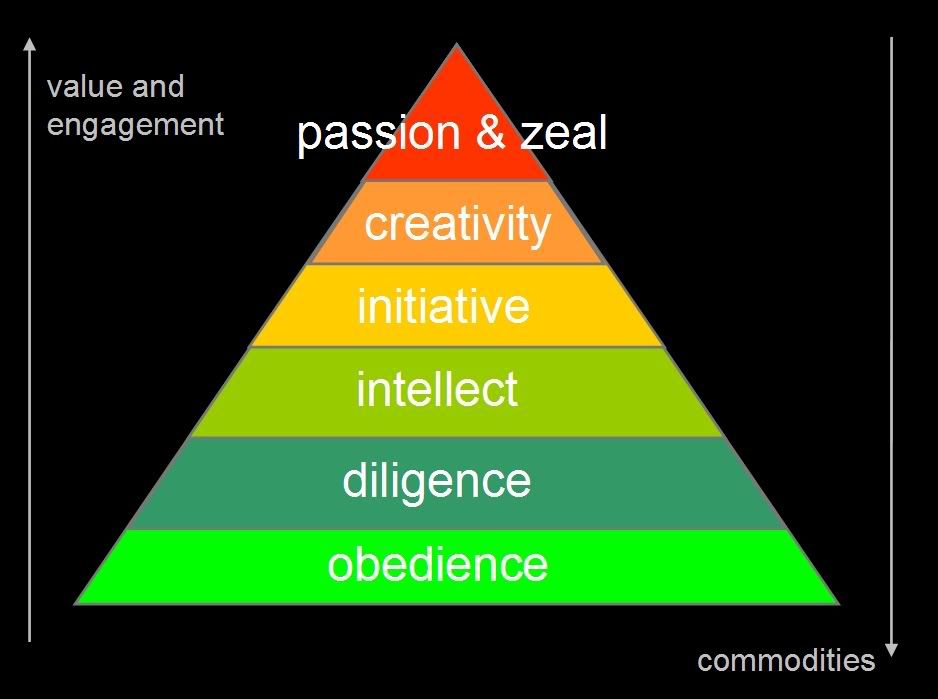Dr. Gary Hamel has an article in the new February issue of Harvard Business Review titled "Moon Shots for Management". It is a fantastic article, unfortunately
limited to subscribers. I have
posted on this topic before, but this article goes into much more detail and articulates its points better. It's in absolute alignment with everything we hope to facilitate with OpenTeams and Organization 2.0. The summary:
Idea in Brief • “Modern” management, much of which dates back to the late nineteenth century, has reached the limits of improvement.
• To lay out a road map for reinvention, a group of scholars and CEOs has created 25 ambitious challenges.
• Unless management innovators tackle those issues, companies will be unable to cope with tomorrow’s volatile world.
Management's Grand Challenges 1: Ensure that the work of management serves a higher purpose. Management, both in theory and practice, must orient itself to the achievement of noble, socially significant goals.
2: Fully embed the ideas of community and citizenship in management systems. There’s a need for processes and practices that reflect the interdependence of all stakeholder groups.
3: Reconstruct management’s philosophical foundations. To build organizations that are more than merely efficient, we will need to draw lessons from such fields as biology, political science, and theology.
4: Eliminate the pathologies of formal hierarchy. There are advantages to natural hierarchies, where power flows up from the bottom and leaders emerge instead of being appointed.
5: Reduce fear and increase trust. Mistrust and fear are toxic to innovation and engagement and must be wrung out of tomorrow’s management systems.
6: Reinvent the means of control. To transcend the discipline-versus-freedom trade-off, control systems will have to encourage control from within rather than constraints from without.
7: Redefine the work of leadership. The notion of the leader as a heroic decision maker is untenable. Leaders must be recast as social-systems architects who enable innovation and collaboration.
8: Expand and exploit diversity. We must create a management system that values diversity, disagreement, and divergence as much as conformance, consensus, and cohesion.
9: Reinvent strategy making as an emergent process. In a turbulent world, strategy making must reflect the biological principles of variety, selection, and retention.
10: De-structure and disaggregate the organization. To become more adaptable and innovative, large entities must be disaggregated into smaller, more malleable units.
11: Dramatically reduce the pull of the past. Existing management systems often mindlessly reinforce the status quo. In the future, they must facilitate innovation and change.
12: Share the work of setting direction. To engender commitment, the responsibility for goal setting must be distributed through a process in which share of voice is a function of insight, not power.
13: Develop holistic performance measures. Existing performance metrics must be recast, since they give inadequate attention to the critical human capabilities that drive success in the creative economy.
14: Stretch executive time frames and perspectives. We need to discover alternatives to compensation and reward systems that encourage managers to sacrifice long-term goals for short-term gains.
15: Create a democracy of information. Companies need information systems that equip every employee to act in the interests of the entire enterprise.
16: Empower the renegades and disarm the reactionaries. Management systems must give more power to employees whose emotional equity is invested in the future rather than the past.
17: Expand the scope of employee autonomy. Management systems must be redesigned to facilitate grassroots initiatives and local experimentation.
18: Create internal markets for ideas, talent, and resources. Markets are better than hierarchies at allocating resources, and companies’ resource allocation processes need to reflect this fact.
19: Depoliticize decision making. Decision processes must be free of positional biases and should exploit the collective wisdom of the entire organization and beyond.
20: Better optimize trade-offs. Management systems tend to force either-or choices. What’s needed are hybrid systems that subtly optimize key trade-offs.
21: Further unleash human imagination. Much is known about what engenders human creativity. This knowledge must be better applied in the design of management systems.
22: Enable communities of passion. To maximize employee engagement, management systems must facilitate the formation of self-defining communities of passion.
23: Retool management for an open world. Value-creating networks often transcend the firm’s boundaries and can render traditional power-based management tools ineffective. New management tools are needed for building and shaping complex ecosystems.
24: Humanize the language and practice of business. Tomorrow’s management systems must give as much credence to such timeless human ideals as beauty, justice, and community as they do to the traditional goals of efficiency, advantage, and profit.
25: Retrain managerial minds. Managers’ deductive and analytical skills must be complemented by conceptual and systems-thinking skills.



